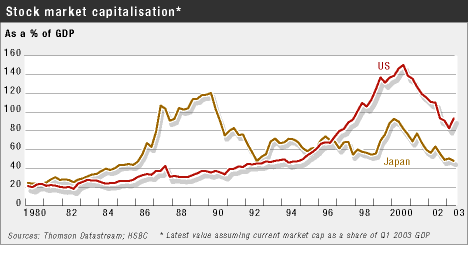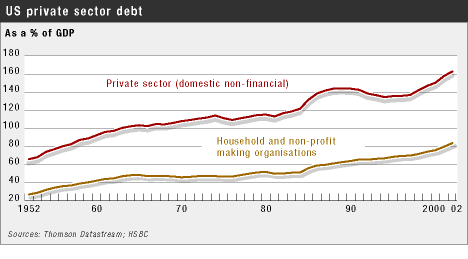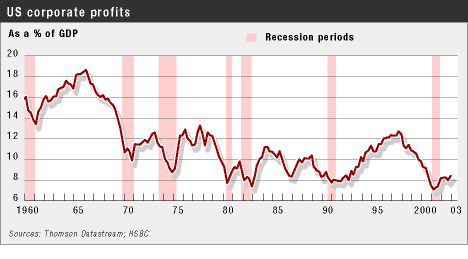
Bubbles have three stages: expansionary; then contractionary; and, finally, perhaps inflationary. The world economy is now in the second stage. That is why today's worry is deflation. But it is unlikely to stay there for ever. Ultimately, efforts to ward off post-bubble deflation risk creating its opposite.
Martin Wolf Financial Times 28/5 2003
Macroeconomists are argumentative. They are never more so than at cyclical turning-points. So today some see deflation on the horizon and others warn of a return of inflation, while the mainstream predicts modest but sustained recovery. The mainstream view has been wrong enough, often enough, in the past five years to justify considering the alternatives.
In fact, both of them may be right. How might the world economy be threatened with both deflation and inflation? The answer is to be found in the development of huge asset price bubbles. Bubbles have three stages: expansionary; then contractionary; and, finally, perhaps inflationary. The world economy is now in the second stage. That is why today's worry is deflation. But it is unlikely to stay there for ever. Ultimately, efforts to ward off post-bubble deflation risk creating its opposite.
During bubbles people make huge mistakes. Investors pay too much; companies invest too much; households spend and borrow too much; and the government believes temporary fiscal surpluses are permanent. If global economic conditions are accommodating, there may be little general inflation during the bubble era, despite the rapid economic expansion. Inflation-targeting monetary authorities may even talk about productivity miracles, as they stand complacently by. This should sound familiar to those who followed Alan Greenspan's Federal Reserve.
Because people make exceptionally large mistakes, orthodox neoclassical economics does not work very well. A more helpful guide is the Swedish-Austrian theory of the business cycle, developed by Knut Wicksell, the Swedish economist, and Friedrich Hayek, the Austrian, in the 1920s and 1930s. During such periods, they argued, the real interest rate is too low and monetary policy too loose, given the over-optimistic view of prospective returns on capital.
Exuberance ultimately drives asset prices so far from reality that they can no longer be suspended by their own boot straps. Then, when the bubble bursts, a dismal scene comes into view. Not only is there too much capital; there is also excessive debt. Investment collapses and saving rises. The mechanism for turning a debt-fuelled asset-price boom into depression was described by another great economist, the American Irving Fisher, in his theory of "debt-deflation". With falling prices, the real value of debt rises. The indebted cut back their spending. This then generates further declines in output and prices.
How then, in this post-bubble stage, might the authorities respond? They drink the hair of the dog that bit them, by creating yet more debt. They cut interest rates, to encourage the private sector to borrow and, if this does not work, the fiscal deficit explodes.
Japan has relied heavily on the public sector mechanism, because the private mechanism has been blocked by the impossibility of generating another property boom and by the destruction of the solvency of a property-dependent banking system. The US, with a healthier banking system and no concomitant property bubble, has been far more successful in stimulating private borrowing, as short-term interest rates have fallen from from 6.5 per cent to 1.25 per cent. But the fiscal response has also been huge. Between 2000 and 2003, according to the Organisation for Economic Co-operation and Development, the US general government fiscal balance will have moved from plus 1.4 per cent of gross domestic product to minus 4.6 per cent - a swing of 6 per cent of GDP in three years. This is only a little smaller, and far quicker, than the swing in post-bubble Japan's balance, from plus 1.8 per cent of GDP in 1991 to minus 4.9 per cent in 1996.

That the Federal Reserve is concerned today about the risk of deflation, despite this stimulus, demonstrates the impact of the bursting of the bubble. The point is made in an outstanding analysis from Stephen King of HSBC. Thinking the Unthinkable: Unconventional Ways of Fighting Deflation", May 2003, (apply to nicholas.ray@hsbcib.com )
Mr King notes that five steps can be taken to deal with post-bubble contractions: slashing interest rates; Keynesian fiscal loosening; manipulating the yield curve; providing general debt bail-outs; and creating inflationary expectations. In Japan, we have already seen the first three. In the US we are also into the third. That leaves the last two. But the most effective way of achieving them both is to flood the economy with money.
Look at public sector indebtedness and the burden of private debt in deflationary Japan. The ratio of gross public debt to GDP has risen from 61 per cent in 1991 to a forecast of 151 per cent this year. Another decade like this would bring it close to 300 per cent. An inflationary blow-out would then seem inevitable.

What about the US? The implicit policies of generating household and public debt, to move the economy out of its post-bubble mire, also create inflationary dangers. In particular, the US is dependent on a net capital inflow of some $500bn a year. At present, however, long-term interest rates are only 3.4 per cent. With stock markets still expensive and interest rates so low, there is little to support the dollar. Should its fall become rapid, long-term rates are quite likely to rise.
The Federal Reserve would then be pulled in two ways. Should it continue with its present policies, inflation could become a threat. Should it fail to do so, further contraction would be more likely. If the dollar weakened further, the pressure on other central banks - including the European Central Bank - to ease monetary policy dramatically could also be huge, so spreading the monetary easing worldwide.

Huge asset price bubbles create profound disturbances. When they start in the world's biggest economy, those disturbances are global. In the post-bubble contractionary phase, the worry is deflation. But if the response is to generate a rising tide of private and public debt, the end-game is more likely to be the writing off of that debt, via inflation. It seems entirely plausible that 10 or, perhaps, as long as 20 years from now, economists will be far more worried about inflation than about deflation.
Den annalkande stormen
Rolf Englund 1987-10-26
För Svensk Tidskrift nr 9/87
Claudio Borio, the BIS's chief economist,
says this refusal to let the business cycle run its course and to purge bad debts is corrosive.
leads to "time inconsistency". It steals growth and prosperity from the future, and pulls the interest rate structure far below its (Wicksellian) natural rate.
"The risk is that the global economy may be in a deceptively stable disequilibrium," he said.
Ambrose Evans-Pritchard 4 June 2014